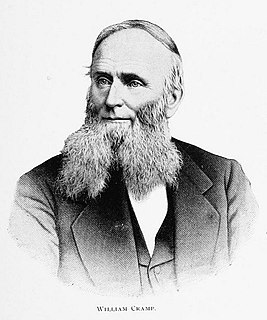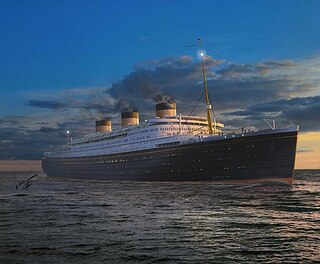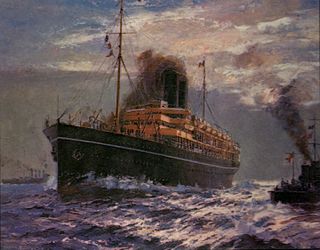
Kaiser Wilhelm der Grosse was a German transatlantic ocean liner named after Wilhelm I, German Emperor, the first monarch of the (second) German Empire.

A steamship, often referred to as a steamer, is a type of steam-powered vessel, typically ocean-faring and seaworthy, that is propelled by one or more steam engines that typically move (turn) propellers or paddlewheels. The first steamships came into practical usage during the early 1800s; however, there were exceptions that came before. Steamships usually use the prefix designations of "PS" for paddle steamer or "SS" for screw steamer. As paddle steamers became less common, "SS" is assumed by many to stand for "steam ship". Ships powered by internal combustion engines use a prefix such as "MV" for motor vessel, so it is not correct to use "SS" for most modern vessels.

William Cramp & Sons Shipbuilding Company of Philadelphia was founded in 1830 by William Cramp, and was the preeminent U.S. iron shipbuilder of the late 19th century. In 1890 the company built the battleships USS Indiana and USS Massachusetts, armored cruiser USS New York, and protected cruiser USS Columbia. Three of these ships took a part in the battle with the Spanish fleet in 1898 at Santiago de Cuba. The victory in this battle heralded America's emergence as a great power. The American Shipping and Commercial Corporation bought the yard in 1919 but closed it in 1927 as fewer ships were ordered by the U.S. Navy after passage of the Naval Limitations Treaty in 1923.
Transatlantic crossings are passages of passengers and cargo across the Atlantic Ocean between Europe or Africa and the Americas. The majority of passenger traffic is across the North Atlantic between Western Europe and North America. Centuries after the dwindling of sporadic Viking trade with Markland, a regular and lasting transatlantic trade route was established in 1566 with the Spanish West Indies fleets, following the Voyages of Christopher Columbus.

An ocean liner is a passenger ship primarily used as a form of transportation across seas or oceans. Liners may also carry cargo or mail, and may sometimes be used for other purposes.

SS United States is a retired ocean liner built in 1950–51 for the United States Lines at a cost of US$79.4 million. The ship is the largest ocean liner constructed entirely in the United States and the fastest ocean liner to cross the Atlantic in either direction, retaining the Blue Riband for the highest average speed since her maiden voyage in 1952. She was designed by American naval architect William Francis Gibbs and could be converted into a troopship if required by the Navy in time of war. The United States maintained an uninterrupted schedule of transatlantic passenger service until 1969 and was never used as a troopship.

A troopship is a ship used to carry soldiers, either in peacetime or wartime. Operationally, standard troopships–often drafted from commercial shipping fleets–cannot land troops directly on shore, typically loading and unloading at a seaport or onto smaller vessels, either tenders or barges.

The RMMV Oceanic was the planned name of an unfinished ocean liner that was partially built by Harland and Wolff for the White Star Line. The ship was to have been the first 1,000-foot (300 m)-long ocean liner. It was intended to be the largest ocean liner for the White Star Line, thus it would have been larger than the earlier White Star giants, Olympic, Titanic, Britannic, and Majestic.

SS Europa, later SS Liberté, IMO 5607332, was a German ocean liner built for the Norddeutsche Lloyd line (NDL) to work the transatlantic sea route. She and her sister ship, Bremen, were the two most advanced, high-speed steam turbine ocean vessels in their day, with both earning the Blue Riband.

The Compagnie Générale Transatlantique, typically known overseas as the French Line, was a French shipping company. Established in 1855 by the brothers Émile and Issac Péreire under the name Compagnie Générale Maritime, the company was entrusted by the French government to transport mails to North America. In 1861, the name of the company was changed to Compagnie Générale Transatlantique. The company's first vessel, the SS Washington, had its maiden voyage on 15 June 1864. After a period of trials and errors in the late 19th century, the company, under the direction of its presidents Jules Charles-Roux and John Dal Piaz, gained fame in the 1910s and 1930s with its prestigious ocean liners such as SS Paris, SS Île de France, and especially SS Normandie. Fragilized by the Second World War, the company regained its fame in 1962 with the famous SS France, which suffered major competition from air transport and was retired from service in 1974. In 1977, the company merged with the Compagnie des Messageries Maritimes to form the Compagnie Générale Maritime. Then, in 1996, the company Compagnie Générale Maritime merged to form the CMA CGM.

The fifth SS Rotterdam, also known as "The Grande Dame", is a former ocean liner and cruise ship, and has been a hotel ship in Rotterdam, the Netherlands, since 2010. She was launched by Queen Juliana of the Netherlands in a gala ceremony on 13 September 1958, and was completed the following summer. The Rotterdam was the last great Dutch "ship of state", employing the finest artisans from the Netherlands in her construction and fitting out process. Her career spanned forty-one years. She sailed from 1959 until her final retirement in September 2000.
SS Champlain was a cabin class ocean liner built in 1932 for the French Line by Chantiers et Ateliers de Saint-Nazaire, Penhoët. She was sunk by a mine off La Pallice, France, in 1940—one of the earliest passenger ship losses of the Second World War.

SS Servia, also known as RMS Servia, was a successful transatlantic passenger and mail steamer of revolutionary design, built by J & G Thomson of Clydebank and launched in 1881. She was the first large ocean liner to be built of steel instead of iron, and the first Cunard ship to have an electric lighting installation. For these and other reasons, maritime historians often consider Servia to be the first "modern" ocean liner.

SS Independence was a US built and flagged ocean liner which entered service in February 1951 for American Export Lines. Between 1974 and 1982 the vessel sailed as Oceanic Independence for Atlantic Far East Lines and American Hawaii Cruises, before reverting to the original name. Independence was then operated by American Global Line between 1982 and 1996, and again American Hawaii Cruises until being laid up in San Francisco in 2001.
SS California may refer to:

A four-funnel liner is an ocean liner with four funnels. Great Eastern, launched 40 years prior to any other comparable ship in 1858, was the only ocean liner to have five funnels. Kaiser Wilhelm der Grosse, launched in 1897, was the first ocean liner to have four funnels and was one of the first of the golden era of ocean liners that became prominent in the 20th century.

The Athenic-class ocean liners were a three ship class of ocean liners built by the Harland & Wolff shipyard for the White Star Line in the early 20th century.

RMS Medina was an ocean liner built by Caird and Company, Greenock, Scotland, in 1911, for the Peninsular and Oriental Steam Navigation Company. She was a Royal Mail Ship intended for use on the London to Australia route and was the last of the ten ships in P&O's M-Class.

SS Princess Adelaide was a passenger vessel in the coastal service fleet of the Canadian Pacific Railway (CPR) during the first half of the 20th century.















